Seasonal
differencing
Seasonal
difference (season-to-season change)
First difference of seasonal difference
The seasonal
difference of a time series is the series of changes from one season
to the next. For monthly data, in which there are 12 periods in a season, the
seasonal difference of Y at period t is Y(t)-Y(t-12).
In Statgraphics, the seasonal difference of Y with a
seasonal period of 12 is expressed as SDIFF(Y,12),
although you should not often need to use this expression: seasonal
differencing, like nonseasonal differencing, can be
performed as an analysis option within the time
series procedures. If the seasonal difference of Y is "pure noise"
(constant variance, no autocorrelation, etc.), then Y is described by a seasonal random walk model: each value is a random step
away from the value that occurred exactly one season ago.
Seasonal differencing is a
crude form of additive seasonal adjustment: the "index" which is
subtracted from each value of the time series is simply the value that was
observed in the same season one year earlier. Seasonal differencing therefore
usually removes the gross features of seasonality from a series, as well as
most of the trend. Here is a plot of the seasonal difference of AUTOSALE/CPI,
the deflated auto sales series. Notice that little remains of the original
seasonal pattern or trend, although it now looks a bit like a random walk
rather than pure noise.
First
difference of seasonal difference: In the preceding two graphs, we see that the first
difference of AUTOSALE/CPI is far from random (it is still strongly seasonal),
and the seasonal difference is far from stationary (it resembles a random
walk). In this case, it appears that both kinds of differencing are
needed to render the series stationary and to account for the gross pattern of
seasonality. The first difference of the seasonal difference of a
monthly time series Y at period t is equal to (Y(t) -
Y(t-12)) - (Y(t-1) - Y(t-13)). Equivalently, it is equal to (Y(t)
- Y(t-1)) - (Y(t-12) - Y(t-13)). This is the amount by which the change from
the previous period to the current period is different from the change that was
observed exactly one year earlier. Thus, for example, the first difference of
the seasonal difference in September 1995 is equal to the August-to-September change
in 1995 minus the August-to-September change in 1994. If the first difference
of the seasonal difference of Y is pure noise, then Y is described by a seasonal random trend model.
In Statgraphics,
the first difference of the seasonal difference of Y is expressed as DIFF(SDIFF(Y,12)), although, as noted above, you shouldn't
need to use this expression very often. (Use the "analysis options"
to perform all the necessary differencing inside the time series procedures.)
Here is a plot of the first difference of the seasonal difference of
AUTOSALE/CPI. Note that it now appears stationary without obvious signs of
seasonality. (We should look at an autocorrelation plot to be sure that no
seasonal pattern remains, but at least the gross seasonal pattern has been
eliminated.)
The following spreadsheet
shows how the seasonal difference and first difference of the seasonal
difference are calculated in this example:
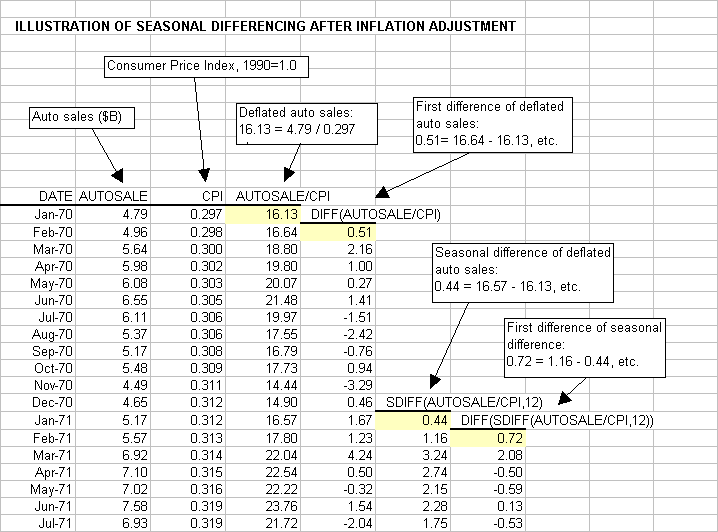
Seasonal
random walk model
If the seasonal difference
(i.e., the season-to-season change) of a time series looks like stationary
noise, this suggests that the mean (constant) forecasting model should be
applied to the seasonal difference. For monthly data, whose seasonal period is
12, the seasonal difference at period t is Y(t)-Y(t-12).
Applying the mean model to this series yields the equation:
Y(t) - Y(t-12) = 
...where
alpha is the the mean of the seasonal
difference--i.e., the average annual trend in the data. Rearranging terms to put Y(t) on the left, we obtain:
Y(t) = Y(t-12) +
This forecasting model
will be called the seasonal random walk model, because it assumes that
each season's values form an independent random walk. Thus, the model assumes
that September's 's value this year is a random step away from September's
value last year, October's value this year is a random step away from October's
value last year, etc., and the mean value of every step is equal to the same
constant (denoted here as alpha). That is,
Y(Sep'96) = Y(Sep'95) +
Y(Oct'96) = Y(Oct'95) +
and so on. Notice that the forecast
for Sep'96 ignores all data after Sep'95--i.e., it is based entirely on what
happened exactly one year ago.
A seasonal random walk
model is a special case of an ARIMA model in which there is one order of
seasonal differencing, a constant term, and no other
parameters--i.e., an "ARIMA(0,0,0)x(0,1,0) model with constant." To
specify a seasonal random walk model in Statgraphics,
choose ARIMA as the model type and use the following settings:
- Differencing: Nonseasonal
Order = 0, Seasonal Order = 1
- AR, MA, SAR, SMA = 0
- Constant = ON
The seasonal
difference of the deflated auto sales data
(AUTOSALE/CPI) does not quite look like stationary noise: it is rather highly
correlated. If we fit the seasonal random walk model anyway (using the ARIMA
option in Statgraphics), we obtain the following
forecast plot:
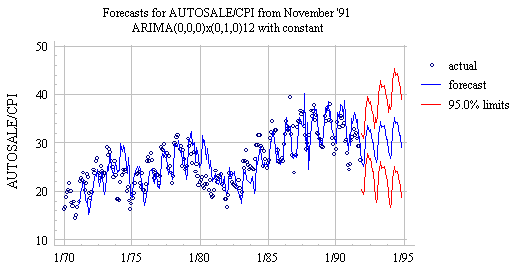
The distinctive feature of
the forecasts produced by this model is that future seasonal cycles are
predicted to have exactly the same shape as the most recently completed
seasonal cycle, and the trend in the forecasts equals the average trend
calculated over the whole history of the time series. If you look closely at
the plot, you will notice that the model does not respond very quickly to
cyclical upturns and downturns in the data: it is always looking exactly one
year behind and assuming that the current trend equals the average trend, so
that when the trend takes a cyclical upward or downward turn, the forecasts may
miss badly in the same direction for many months in a row. Thus, the one-step-ahead
forecast errors typically show positive autocorrelation. However, the long-term
forecasts beyond the end of the sample appear reasonable insofar as they assume
that the average trend in the past will eventually prevail again in the future.
Another distinctive
feature of the seasonal random walk model is that it is relatively stable in
the presence of sudden changes in the data--indeed, it
doesn't even notice them for 12 months! For example, the previous plot shows
long-term forecasts produced from time origin November 1991, at the end of a
downward cycle. A few months later, the data begins to trend upward, but the
long-term forecasts produced by the seasonal random walk model look much the
same as before:
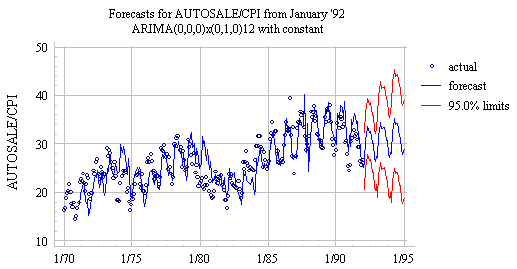
The positive
autocorrelation in the errors of the seasonal random walk model can be reduced
by adding a lag-1 autoregressive ("AR(1)")
term to the forecasting equation. (In Statgraphics,
you would do this by additionally setting AR=1). This yields an "ARIMA(1,0,0)x(0,1,0) model with constant," and its
performance on the deflated auto sales series (from time origin November 1991)
is shown here:
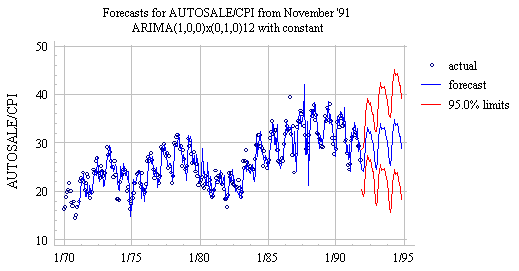
Notice the much quicker reponse to cyclical turning points. The in-sample RMSE for
this model is only 2.05, versus 2.98 for the seasonal random walk model without
the AR(1) term. (Return to top of
page.)
Go
to next topic: seasonal random trend model
Seasonal
random trend model
Often a time series which
has a strong seasonal pattern is not satisfactorily stationarized
by a seasonal difference alone, and hence the seasonal
random walk model (which predicts the seasonal difference to be constant)
will not give a good fit. For example, the seasonal
difference of the deflated auto sales series looks more like a random walk
than a stationary noise pattern. However, if we look at the first difference of the seasonal difference of
deflated auto sales, we see a pattern that looks more-or-less like stationary
noise with a mean value of zero:
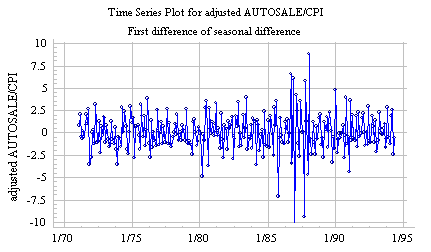
(Even if the mean value of
a twice-differenced series is not exactly zero, we normally assume it is zero
for forecasting purposes: otherwise we would be assuming a trend-in-the-trend,
which would be dangerous to extrapolate very far.)
For monthly data, whose
seasonal period is 12, the first difference of the seasonal difference at
period t is (Y(t) - Y(t-12)) - (Y(t-1) - Y(t-13).
Applying the zero-mean forecasting model to this series yields the equation:
(Y(t)
- Y(t-12)) - (Y(t-1) - Y(t-13)) = 0
Rearranging terms to put Y(t) by itself on the left, we obtain:
Y(t) = Y(t-1) + Y(t-12) - Y(t-13)
For example, if it is now
September '96 and we are using this equation to predict the value of Y in
October '96, we would compute:
Y(Oct'96) = Y(Sep'96) + (Y(Oct'95) -
Y(Sep'95)).
In other words, October's
forecast equals September's value plus the September-to-October change observed
last year. Equivalently, we can rewrite this as:
Y(Oct'96) = Y(Oct'95) + (Y(Sep'96) -
Y(Sep'95)),
which says that October's forecast
equals last October's value plus the year-to-year change we observed last
month. (These preceding two equations are mathematically identical: we've just
rearranged terms on the right-hand-side.)
This forecasting model
will be called the seasonal random trend model, because it assumes that
the seasonal trend (difference) observed this month is a random step away from
the trend that was observed last month, where the steps are assumed to have
mean zero. To see this, rewrite the equation in terms of seasonal differences:
Y(t) - Y(t-12)) = Y(t-1) - Y(t-13)
In other words, the
expected seasonal difference this month is the same as the seasonal difference
observed last month. Now compare this behavior with that of the seasonal random walk model: the seasonal random walk
model assumes that the expected values of all future seasonal differences are
equal to the average seasonal difference calculated over the whole
history of the time series. In contrast, the seasonal random trend model
assumes that the expected values of all future seasonal differences are equal
to the most recently observed seasonal difference. Moreover, the
seasonal random trend model assumes that the actual seasonal differences will
be undergoing a zero-growth random walk--rather than fluctuating around some
constant mean value--so their values will become very uncertain in the distant
future.
The seasonal random walk
model and the seasonal random trend model both predict that next year's
seasonal cycle will have exactly the same shape (i.e., the same relative
month-to-month changes) as this year's seasonal cycle. The difference between
them is in their trend projections: the seasonal random walk model
assumes that the future trend will equal the average year-to-year trend
observed in the past, whereas the seasonal random trend model assumes that the
future trend will equal the most recent year-to-year trend.
Returning to our example,
if our last recorded value was for September '96, the seasonal random trend
model will predict October's value to satisfy Y(Oct'96)
- Y(Oct'95) = Y(Sep'96) - Y(Sep'95). If we then bootstrap the model one month
into the future to predict November's value, the model will predict that Y(Nov'96) - Y(Nov'95) = Y(Oct'96) - Y(Oct'95) ...but this is
exactly equal to Y(Sep'96) - Y(Sep'95) again, because the October '96 forecast
must be used in place of an actual value. Thus, all future seasonal
differences, as predicted from time origin September '96, will be identical to
the September-to-September difference.
The seasonal random trend
model is a special case of an ARIMA model in which there is one order of
non-seasonal differencing, one order of seasonal differencing, and no constant
or other parameters--i.e., an "ARIMA(0,1,0)x(0,1,0) model." In Statgraphics, you would specify a seasonal random trend
model by choosing ARIMA as the model type and then selecting:
- Differencing: Nonseasonal
Order = 1, Seasonal Order = 1
- AR, MA, SAR, SMA = 0
- Constant = off
If we apply the seasonal
random trend model to the deflated auto sales data, using data up to November
'91, we obtain the following picture:

Notice that the
one-step-ahead predictions (up to November '91) respond very quickly to cyclical
upturns and downturns in the data, unlike those of the seasonal random walk
model. Also notice that the predictions for future seasonal cycles have exactly
the same shape as the last observed seasonal cycle (the one ending in November
'91). However, the long-term forecasts march off with a downward trend equal to
the downward trend that was observed from November '90 to November '91. The
confidence limits for the long-term forecasts also diverge very rapidly because
of the assumption that the actual future trend will be randomly changing.
If we recompute
the forecasts using data up to January '92, we see a very different picture in
the long-term forecasts:

The upward trend between
January '91 and January '92 now causes the long-term forecasts to shoot off
upward! Thus, we see that the seasonal random trend model is much more
responsive than the seasonal random walk model to sudden shifts in the data.
This serves it well when forecasting one period ahead, but renders it rather
unstable for purposes of forecasting many periods ahead.
If you are thinking at
this point that it probably would be better to do some amount of smoothing
when estimating the seasonal pattern and/or the long-term trend in the
forecasts, you are right. (By "smoothing" I mean that you might want
to average over the last few season's data when
estimating the seasonal pattern and/or the trend.) You can smooth the trend
estimate by adding MA=1 to the parameter specifications, and you can
smooth the estimate of the seasonal pattern by setting SMA=1. Adding
both of these terms will yield an "ARIMA(0,1,1)x(0,1,1)
model," which is probably the most commonly used ARIMA model for seasonal
data. (For the technically curious, setting MA=1 adds a multiple of the
one-month-prior forecast error to the right-hand-side of the forecasting
equation, while setting SMA=1 adds a multiple of the 12-month-prior error,
and adding both terms together also causes a multiple of the 13-month-prior
error to be included. The resulting model is a kind of "seasonal linear
exponential smoothing.") The forecasts generated by this model from time
origin November '91 indeed show a smoother seasonal pattern, a more conservative
trend estimate, and narrower confidence intervals:

The preceding qualitative
observations are confirmed by the model comparison
report for the seasonal random walk, seasonal random trend, and more
elaborate ARIMA models fitted to the deflated auto sales data. The seasonal
random trend model outperforms the seasonal random walk model within the
estimation and validation periods (i.e., for all one-step-ahead forecasts), and
the more elaborate models with additional ARIMA parameters improve on the
simpler models without those parameters. (Return to top of
page.)
Seasonal
ARIMA models
Outline
of seasonal ARIMA modeling
Example: AUTOSALE series revisited
The oft-used ARIMA(0,1,1)x(0,1,1) model: SRT model plus MA(1)
and SMA(1) terms
The ARIMA(1,0,0)x(0,1,0) model with constant: SRW model plus
AR(1) term
An improved version: ARIMA(1,0,1)x(0,1,1) with constant
Seasonal ARIMA versus exponential smoothing and seasonal
adjustment
What are the tradeoffs among the various seasonal models?
To log or not to log?
Outline
of seasonal ARIMA modeling:
- The seasonal part of an ARIMA model has the same
structure as the non-seasonal part: it may have an AR factor, an MA
factor, and/or an order of differencing. In the seasonal part of the
model, all of these factors operate across multiples of lag s (the
number of periods in a season).
- A seasonal ARIMA model is classified as an ARIMA(p,d,q)x(P,D,Q) model, where P=number of seasonal
autoregressive (SAR) terms, D=number of seasonal differences, Q=number of
seasonal moving average (SMA) terms
- In identifying a seasonal model, the first
step is to determine whether or not a seasonal difference is
needed, in addition to or perhaps instead of a non-seasonal difference.
You should look at time series plots and ACF and PACF plots for all
possible combinations of 0 or 1 non-seasonal difference and 0 or 1
seasonal difference. Caution: don't EVER use more
than ONE seasonal difference, nor more than TWO total differences
(seasonal and non-seasonal combined).
- If the seasonal pattern is both strong and stable
over time (e.g., high in the Summer and low in the Winter, or vice versa),
then you probably should use a seasonal difference regardless of
whether you use a non-seasonal difference, since this will prevent the
seasonal pattern from "dying out" in the long-term forecasts.
Let's add this to our list of rules for identifying models
Rule 12: If the series has a strong and consistent seasonal pattern, then you should use an order of seasonal differencing--but never use more than one order of seasonal differencing or more than 2 orders of total differencing (seasonal+nonseasonal). - The signature of pure SAR or pure SMA
behavior is similar to the signature of pure AR or pure MA behavior,
except that the pattern appears across multiples of lag s in the ACF and
PACF.
- For example, a pure SAR(1)
process has spikes in the ACF at lags s, 2s, 3s, etc., while the PACF cuts
off after lag s.
- Conversely, a pure SMA(1)
process has spikes in the PACF at lags s, 2s, 3s, etc., while the ACF cuts
off after lag s.
- An SAR signature usually occurs when the
autocorrelation at the seasonal period is positive, whereas an SMA
signature usually occurs when the seasonal autocorrelation is negative,
hence:
Rule 13: If the autocorrelation at the seasonal period is positive, consider adding an SAR term to the model. If the autocorrelation at the seasonal period is negative, consider adding an SMA term to the model. Do not mix SAR and SMA terms in the same model, and avoid using more than one of either kind. - Usually an SAR(1) or SMA(1)
term is sufficient. You will rarely encounter a genuine SAR(2) or SMA(2)
process, and even more rarely have enough data to estimate 2 or more
seasonal coefficients without the estimation algorithm getting into a
"feedback loop."
- Although a seasonal ARIMA model seems to have only a
few parameters, remember that backforecasting
requires the estimation of one or two seasons' worth of implicit
parameters to initialize it. Therefore, you should have at least 4 or 5
seasons of data to fit a seasonal ARIMA model.
- Probably the most commonly used seasonal ARIMA model
is the (0,1,1)x(0,1,1) model--i.e., an MA(1)xSMA(1)
model with both a seasonal and a non-seasonal difference. This is
essentially a "seasonal exponential smoothing" model.
- When seasonal ARIMA models are fitted to logged
data, they are capable of tracking a multiplicative seasonal
pattern.
Example:
AUTOSALE series revisited
Recall that we previously
forecast the retail auto sales series by using a combination of deflation,
seasonal adjustment and exponential smoothing. Let's now try fitting the same
series with seasonal ARIMA models. As before we will work with deflated
auto sales--i.e., we will use the series AUTOSALE/CPI as the input variable.
Here are the time series plot and ACF and PACF plots of the original series,
which are obtained in the Forecasting procedure by plotting the
"residuals" of an ARIMA(0,0,0)x(0,0,0) model with constant:

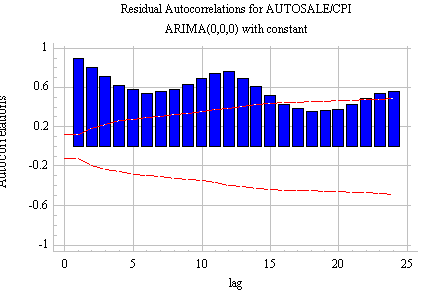

The "suspension
bridge" pattern in the ACF is typical of a series that is both nonstationary and strongly seasonal. Clearly we need at
least one order of differencing. If we take a nonseasonal
difference, the corresponding plots are as follows:



The differenced series
(the residuals of a random-walk-with-growth model) looks more-or-less
stationary, but there is still very strong autocorrelation at the seasonal
period (lag 12).
Because the seasonal
pattern is strong and stable, we know (from Rule 12) that we will want to use
an order of seasonal differencing in the model. Here is what the picture
looks like after a seasonal difference (only):
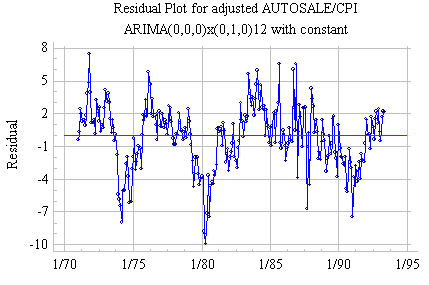


The seasonally differenced
series shows a very strong pattern of positive autocorrelation, as we recall
from our earlier attempt to fit a seasonal random walk
model. This could be an "AR signature"--or it could signal the
need for another difference.
If we take both a seasonal
and nonseasonal difference, following results are
obtained:

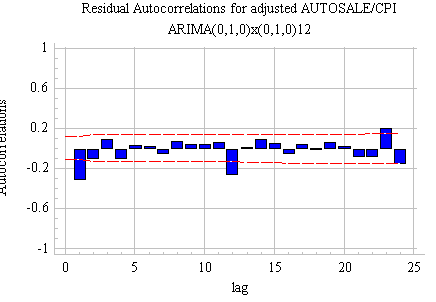

These are, of course, the
residuals from the seasonal random trend model that
we fitted to the auto sales data earlier. We now see the telltale signs of mild
overdifferencing: the positive spikes in the
ACF and PACF have become negative.
What is the correct order
of differencing? One more piece of information that might be helpful is a
calculation of the variance of the series at each level of differencing.
This is just the MSE that results from fitting the various difference-only
ARIMA models:
Model Comparison
----------------
Data variable: AUTOSALE/CPI
Number of observations = 281
Start index = 1/70
Sampling interval = 1.0 month(s)
Length of seasonality = 12
Number of periods withheld for validation: 48
Models
------
(A) ARIMA(0,0,0) with constant
(B) ARIMA(0,1,0) with constant
(C) ARIMA(0,0,0)x(0,1,0)12 with constant
(D) ARIMA(0,1,0)x(0,1,0)12 with constant
Estimation Period
Model MSE MAE MAPE ME MPE
------------------------------------------------------------------------
(A) 26.2264 4.16826 17.1422 -0.00725956 -4.18066
(B) 5.67387 1.79003 7.13332 0.007303 -0.413321
(C) 9.02848 2.30545 9.54065 0.0144368 -0.752748
(D) 4.9044 1.59 6.25023 -0.00265268 -0.120404
We see that the lowest MSE
is obtained by model D which uses one difference of each type. This, together
with the appearance of the plots above, strongly suggests that we should use
both a seasonal and a nonseasonal difference. Note
that, except for the gratuitious constant term, model
D is the seasonal random trend (SRT) model, whereas model B is just the
seasonal random walk (SRW) model. As we noted earlier when comparing these
models, the SRT model appears to fit better than the SRW model. In the analysis
that follows, we will try to improve these models through the addition of
seasonal ARIMA terms.
The
oft-used ARIMA(0,1,1)x(0,1,1) model: SRT model plus MA(1) and SMA(1) terms
Returning to the last set
of plots above, notice that with one difference of each type there is a negative
spike in the ACF at lag 1 and also a negative spike in the ACF at lag 12,
whereas the PACF shows a more gradual "decay" pattern in the vicinity
of both these lags. By applying our rules for
identifying ARIMA models (specifically, Rule 7 and Rule 13), we may now
conclude that the SRT model would be improved by the addition of an MA(1) term and also an SMA(1) term. Also, by Rule 5, we exclude
the constant since two orders of differencing are involved. If we do all
this, we obtain the often-used ARIMA(0,1,1)x(0,1,1) model, whose residual plots
are as follows:


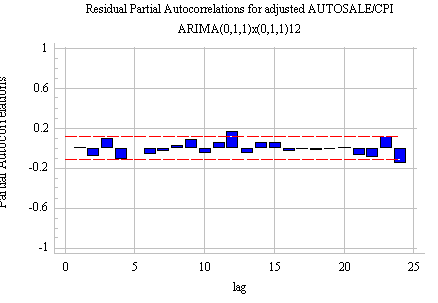
Although a slight amount
of autocorrelation remains at lag 12, the overall appearance of the plots is
good. The model fitting results show that the estimated MA(1)
and SMA(1) coefficients (obtained after 7 iterations) are indeed significant:
Analysis Summary
Data variable: AUTOSALE/CPI
Number of observations = 281
Start index = 1/70
Sampling interval = 1.0 month(s)
Length of seasonality = 12
Forecast Summary
----------------
Nonseasonal differencing of order: 1
Seasonal differencing of order: 1
Forecast model selected: ARIMA(0,1,1)x(0,1,1)12
Number of forecasts generated: 24
Number of periods withheld for validation: 48
Estimation Validation
Statistic Period Period
--------------------------------------------
MSE 2.77303 1.83711
MAE 1.23574 1.05651
MAPE 4.89559 3.47061
ME 0.00985809 -0.135525
MPE -0.246026 -0.614371
ARIMA Model Summary
Parameter Estimate Stnd. Error t P-value
----------------------------------------------------------------------------
MA(1) 0.479676 0.0591557 8.1087 0.000000
SMA(1) 0.906532 0.0267735 33.8593 0.000000
----------------------------------------------------------------------------
Backforecasting: yes
Estimated white noise variance = 2.85055 with 266 degrees of freedom
Estimated white noise standard deviation = 1.68836
Number of iterations: 7
The ARIMA(0,1,1)x(0,1,1)
model is basically a Seasonal Random Trend (SRT) model fine-tuned by the
addition of MA(1) and SMA(1) terms to correct for the mild overdifferencing
that resulted from taking two total orders of differencing. THIS IS PROBABLY
THE MOST COMMONLY USED SEASONAL ARIMA MODEL. The forecasts from the model
resemble those of the seasonal random trend model--i.e., they pick up the
seasonal pattern and the local trend at the end of the series--but they are
slightly smoother in appearance since both the seasonal pattern and the trend
are effectively being averaged (in a exponential-smoothing kind of way) over
the last few seasons:

 Indeed, the value of
the SMA(1) coefficient near 1.0 suggests that many
seasons of data are being averaged over to estimate the seasonal pattern.
(Recall that an MA(1) coefficient corresponds to
"1 minus alpha" in an exponential smoothing model, and that a large
MA(1) coefficient therefore corresponds to a small alpha--i.e., a large average
age of the data in the smoothed forecast. The SMA(1)
coefficient similarly corresponds to "1 minus" a seasonal smoothing
coefficient--and a large value of the SMA(1) coefficient suggests a large
average age measured in units of seasons of data.) The smaller value of
the MA(1) coefficient suggests that relatively little
smoothing is being done to estimate the local level and trend--i.e., only the
last few months of data are being used for that purpose.
Indeed, the value of
the SMA(1) coefficient near 1.0 suggests that many
seasons of data are being averaged over to estimate the seasonal pattern.
(Recall that an MA(1) coefficient corresponds to
"1 minus alpha" in an exponential smoothing model, and that a large
MA(1) coefficient therefore corresponds to a small alpha--i.e., a large average
age of the data in the smoothed forecast. The SMA(1)
coefficient similarly corresponds to "1 minus" a seasonal smoothing
coefficient--and a large value of the SMA(1) coefficient suggests a large
average age measured in units of seasons of data.) The smaller value of
the MA(1) coefficient suggests that relatively little
smoothing is being done to estimate the local level and trend--i.e., only the
last few months of data are being used for that purpose.
The forecasting equation
for this model is:
![]()
where little-theta is the MA(1)
coefficient and big-theta is the SMA(1) coefficient. Notice that this is just
the seasonal random trend model fancied-up by adding multiples of the errors at
lags 1, 12, and 13. Also, notice that the coefficient of the lag-13 error is
the product of the MA(1) and SMA(1) coefficients.
The ARIMA(1,0,0)x(0,1,0) with constant: SRW model plus AR(1)
term
The previous model was a
Seasonal Random Trend (SRT) model fine-tuned by the addition of MA(1) and SMA(1) coefficients. An alternative ARIMA model
for this series can be obtained by substituting an AR(1)
term for the nonseasonal difference--i.e., by adding
an AR(1) term to the Seasonal Random Walk (SRW) model. This will allow us to
preserve the seasonal pattern in the model while lowering the total amount of
differencing, thereby increasing the stability of the trend projections if
desired. (Recall that with one seasonal difference alone, the series did show a
strong AR(1) signature.) If we do this, we obtain an
ARIMA(1,0,0)x(0,1,0) model with constant, which yields the following results:
Analysis Summary
Data variable: AUTOSALE/CPI
Number of observations = 281
Start index = 1/70
Sampling interval = 1,0 month(s)
Length of seasonality = 12
Forecast Summary
----------------
Seasonal differencing of order: 1
Forecast model selected: ARIMA(1,0,0)x(0,1,0)12 with constant
Number of forecasts generated: 24
Number of periods withheld for validation: 48
Estimation Validation
Statistic Period Period
--------------------------------------------
MSE 4,24175 3,04301
MAE 1,4508 1,44661
MAPE 5,73812 4,78971
ME 0,0209967 -0,274249
MPE -0,214828 -1,00671
ARIMA Model Summary
Parameter Estimate Stnd. Error t P-value
----------------------------------------------------------------------------
AR(1) 0,72972 0,046205 15,7931 0,000001
Mean 0,75596 0,508192 1,48755 0,138051
Constant 0,204321
----------------------------------------------------------------------------
Backforecasting: yes
Estimated white noise variance = 4,24182 with 267 degrees of freedom
Estimated white noise standard deviation = 2,05957
Number of iterations: 1
The AR(1)
coefficient is indeed highly significant, and the MSE is only 4.24, compared to
the 9.028 for the unadulterated SRW model (Model B in the comparison report
above). The forecasting equation for this model is:
![]()
The additional term on the
right-hand-side is a multiple of the seasonal difference observed in the last
month, which has the effect of correcting the forecast for the effect of an
unusually "good" or "bad" year. Here "phi"
denotes the AR(1) coefficient, whose estimated value
is 0.73. Thus, for example, if sales last month were X dollars ahead of sales
one year earlier, then the quantity 0.73X would be added to the forecast for
this month.
The forecast plot shows
that the model indeed does a better job than the SRW model of tracking cyclical
changes (i.e., unusually good or bad years):

However, the MSE for this
model is still significantly larger than what we obtained for the
ARIMA(0,1,1)x(0,1,1) model. If we look at the plots of residuals, we see room
for improvement. The residuals still show some sign of cyclical variation:

The ACF and PACF suggest
the need for both MA(1) and SMA(1) coefficients:
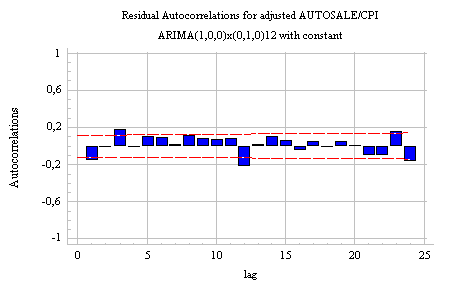

An
improved version: ARIMA(1,0,1)x(0,1,1) with constant
If we add the indicated
MA(1) and SMA(1) terms to the preceding model, we obtain an
ARIMA(1,0,1)x(0,1,1) model with constant. This is nearly the same as the ARIMA(0,1,1)x(0,1,1)
model except that it replaces the nonseasonal
difference with an AR(1) term (a "partial difference") and it
incorporates a constant term representing the long-term trend. Hence, this
model assumes a more stable long-term trend than the ARIMA(0,1,1)x(0,1,1)
model. The model-fitting results are as follows:
Analysis Summary
Data variable: AUTOSALE/CPI
Number of observations = 281
Start index = 1/70
Sampling interval = 1.0 month(s)
Length of seasonality = 12
Forecast Summary
----------------
Seasonal differencing of order: 1
Forecast model selected: ARIMA(1,0,1)x(0,1,1)12 with constant
Number of forecasts generated: 24
Number of periods withheld for validation: 48
Estimation Validation
Statistic Period Period
--------------------------------------------
MSE 2.75399 1.81308
MAE 1.22287 1.05989
MAPE 4.84797 3.49931
ME 0.0297479 -0.262108
MPE -0.23536 -1.04485
ARIMA Model Summary
Parameter Estimate Stnd. Error t P-value
----------------------------------------------------------------------------
AR(1) 0.959688 0.0220179 43.5868 0.000000
MA(1) 0.446023 0.0675235 6.60545 0.000000
SMA(1) 0.905846 0.0272139 33.2861 0.000000
Mean 0.681967 0.259388 2.62914 0.009060
Constant 0.0274918
----------------------------------------------------------------------------
Backforecasting: yes
Estimated white noise variance = 2.80968 with 265 degrees of freedom
Estimated white noise standard deviation = 1.67621
Number of iterations: 9
Notice that the estimated AR(1) coefficient is very close to 1.0 (in fact, less than
two standard errors away from 1.0) and that the other statistics of the model
(the estimated MA(1) and SMA(1) coefficients and error statistics in the
estimation and validation periods) are otherwise nearly identical to those of
the previous model. A constant term has been included in this model because it
has only one order of differencing, and the long-term forecasts from the model
will therefore reflect the average trend over the whole history of the series
rather than the local trend at the end of the series--this is the principal
difference between this model and the preceding one. The estimated MEAN of 0.68
is the average annual increase.
The forecasts from this
model look quite similar to those of the preceding model, because the average
trend is similar to the local trend at the end of the series. However, the
confidence intervals for the model with a lower order of total differencing
widen somewhat less rapidly. Notice that the confidence limits for the
two-year-ahead forecasts now stay within the horizontal grid lines at 24 and
44:
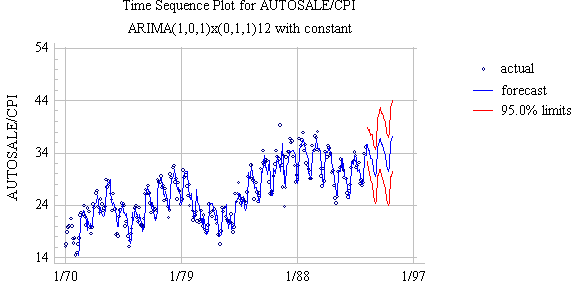
The forecasting equation
for this model is:
![]()
This is the same as the
equation for the ARIMA(0,1,1)x(0,1,1) model, except that an AR(1) coefficient
("phi") now multiplies the Y(t-1)-Y(t-13) term, and a CONSTANT (mu) has been added. When phi is equal to 1 and mu is equal to zero, it becomes exactly the same as
the previous equation--i.e., the AR(1) term becomes
equivalent to a nonseasonal difference.
Seasonal
ARIMA versus exponential smoothing and seasonal adjustment: Now let's compare the performance
the ARIMA models against simple and linear exponential smoothing models
accompanied by multiplicative seasonal adjustment:
Model Comparison
----------------
Data variable: AUTOSALE/CPI
Number of observations = 281
Start index = 1/70
Sampling interval = 1.0 month(s)
Length of seasonality = 12
Number of periods withheld for validation: 48
Models
------
(A) ARIMA(0,1,0)x(0,1,0)12
(B) ARIMA(0,1,1)x(0,1,1)12
(C) ARIMA(1,0,1)x(0,1,1)12 with constant
(D) Simple exponential smoothing with alpha = 0.4772
Seasonal adjustment: Multiplicative
(E) Brown's linear exp. smoothing with alpha = 0.2106
Seasonal adjustment: Multiplicative
Estimation Period
Model MSE MAE MAPE ME MPE
------------------------------------------------------------------------
(A) 4.8821 1.58984 6.24946 0.00164081 -0.10311
(B) 2.77303 1.23574 4.89559 0.00985809 -0.246026
(C) 2.75399 1.22287 4.84797 0.0297479 -0.23536
(D) 2.639 1.18753 4.76707 0.131989 0.233418
(E) 2.78296 1.24417 5.03819 0.00321996 -0.146439
Model RMSE RUNS RUNM AUTO MEAN VAR
-----------------------------------------------
(A) 2.20955 OK * *** OK ***
(B) 1.66524 OK OK OK OK ***
(C) 1.65951 OK OK * OK ***
(D) 1.6245 OK OK *** OK ***
(E) 1.66822 OK OK *** OK ***
Validation Period
Model MSE MAE MAPE ME MPE
------------------------------------------------------------------------
(A) 3.4813 1.45537 4.83928 0.0460732 0.0818369
(B) 1.83711 1.05651 3.47061 -0.135525 -0.614371
(C) 1.81308 1.05989 3.49931 -0.262108 -1.04485
(D) 1.87575 1.07203 3.48819 -0.040363 -0.279181
(E) 1.908 1.07484 3.48071 0.0778136 0.115798
Here, model A is the
seasonal random trend model, models B and C are the two ARIMA models analyzed
above, and models D and E are simple and linear exponential smoothing, respectively,
with multiplicative seasonal adjustment. It's quite hard to pick among the last
four models based on these statistics alone!
What
are the tradeoffs among the various seasonal models? The two models that use
multiplicative seasonal adjustment deal with seasonality in an explicit
fashion--i.e., seasonal indices are broken out as an explicit part of the
model. The ARIMA models deal with seasonality in a more implicit manner--we
can't easily see in the ARIMA output how the average December, say, differs
from the average July. Depending on whether it is deemed important to isolate
the seasonal pattern, this might be a factor in choosing among models. The
ARIMA models have the advantage that, once they have been initialized, they
have fewer "moving parts" than the exponential smoothing and
adjustment models. For example, they could be more compactly implemented on a
spreadsheet.
Between the two ARIMA
models, one (model B) estimates a time-varying trend, while the other (model C)
incorporates a long-term average trend. (We could, if we desired, flatten out
the long-term trend in model C by suppressing the constant term.) Between the
two exponential-smoothing-plus-adjustment models, one (model D) assumes a
"flat" trend at all times, while the other (model E) assumes a
time-varying trend. Therefore, the assumptions we are most comfortable making
about the nature of the long-term trend should be another determining factor in
our choice of models. The models that do not assume time-varying trends
generally have narrower confidence intervals for longer-horizon forecasts.
To log or not to log? Something that we have not yet done, but might have,
is include a log transformation as part of the
model. Seasonal ARIMA models are inherently additive models, so if we
want to capture a multiplicative seasonal pattern, we must do so by
logging the data prior to fitting the ARIMA model. (In Statgraphics,
we would just have to specify "Natural Log" as a modeling option--no
big deal.) In this case, the deflation transformation seems to have done a
satisfactory job of stabilizing the amplitudes of the seasonal cycles, so there
does not appear to be a compelling reason to add a log transformation. If the
residuals showed a marked increase in variance over time, we might decide
otherwise.
Summary of
rules for identifying ARIMA models
Identifying the order
of differencing and the constant:
- Rule 1: If the series has positive autocorrelations
out to a high number of lags, then it probably needs a higher order of
differencing.
- Rule 2: If the lag-1 autocorrelation is zero or
negative, or the autocorrelations are all small and patternless,
then the series does not need a higher order of differencing. If
the lag-1 autocorrelation is -0.5 or more negative, the series may be overdifferenced. BEWARE OF OVERDIFFERENCING!!
- Rule 3: The optimal order of differencing is often
the order of differencing at which the standard deviation is lowest.
- Rule 4: A model with no orders of differencing
assumes that the original series is stationary (among other things,
mean-reverting). A model with one order of differencing assumes
that the original series has a constant average trend (e.g. a random walk
or SES-type model, with or without growth). A model with two orders
of total differencing assumes that the original series has a time-varying
trend (e.g. a random trend or LES-type model).
- Rule 5: A model with no orders of differencing
normally includes a constant term (which represents the mean of the
series). A model with two orders of total differencing normally
does not include a constant term. In a model with one order
of total differencing, a constant term should be included if the series
has a non-zero average trend.
Identifying the numbers
of AR and MA terms:
- Rule 6: If the partial autocorrelation function
(PACF) of the differenced series displays a sharp cutoff and/or the lag-1
autocorrelation is positive--i.e., if the series appears slightly
"underdifferenced"--then consider
adding one or more AR terms to the model. The lag beyond which the
PACF cuts off is the indicated number of AR terms.
- Rule 7: If the autocorrelation function (ACF)
of the differenced series displays a sharp cutoff and/or the lag-1
autocorrelation is negative--i.e., if the series appears slightly
"overdifferenced"--then consider
adding an MA term to the model. The lag beyond which the ACF cuts
off is the indicated number of MA terms.
- Rule 8: It is possible for an AR term and an MA term
to cancel each other's effects, so if a mixed AR-MA model seems to fit the
data, also try a model with one fewer AR term and one fewer MA
term--particularly if the parameter estimates in the original model
require more than 10 iterations to converge.
- Rule 9: If there is a unit root in the AR part of the
model--i.e., if the sum of the AR coefficients is almost exactly 1--you
should reduce the number of AR terms by one and increase the order
of differencing by one.
- Rule 10: If there is a unit root in the MA part of
the model--i.e., if the sum of the MA coefficients is almost exactly
1--you should reduce the number of MA terms by one and reduce the
order of differencing by one.
- Rule 11: If the long-term forecasts appear erratic or
unstable, there may be a unit root in the AR or MA coefficients.
Identifying the
seasonal part of the model:
- Rule 12: If the series has a strong and consistent
seasonal pattern, then you should use an order of seasonal
differencing--but never use more than one order of seasonal differencing
or more than 2 orders of total differencing (seasonal+nonseasonal).
- Rule 13: If the autocorrelation at the seasonal
period is positive, consider adding an SAR term to the
model. If the autocorrelation at the seasonal period is negative,
consider adding an SMA term to the model. Do not mix SAR and SMA
terms in the same model, and avoid using more than one of either kind.

